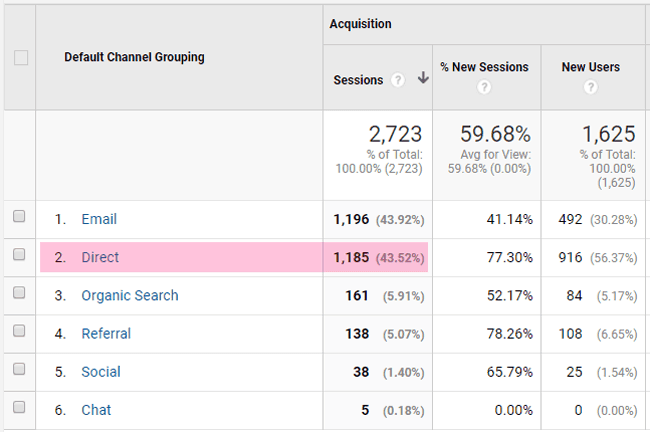Direct Traffic, how I loathe thee
Anyone who has ever used Google Analytics wants to see where there traffic is coming from. And anyone who’s tried to do that has seen something like this:

That big chunk of traffic (often the majority of traffic) labelled as ‘Direct Traffic’. When clicking on that link you will see a series of landing pages with the source labeled ‘Direct’. Normally, you would expect to see something like Google, Facebook, or some other domain that sent you this traffic. So, what does this source ‘Direct’ mean?
If you search the Google Analytics Help Center, you will find that Google defines Direct traffic as “users that typed your URL directly into their browser, or who had bookmarked your site”. OK, simple enough. Someone memorized your website or had it handy in their browser’s bookmarks. Fair right? Not exactly.
While I will accept that some people may get to your site that way, I do not accept that as many do as the analytics report reflects. 60% of your traffic does not come direct traffic where people typing in your domain or jumping to it from a bookmark.
It makes sense but it is still a problem

If you think about it, people could memorize a domain. Prismana.com is easy enough – but you certainly will not be memorizing the entire URL to this article and there will invariably be several entrances to this site directly through this link. Simply put, this direct traffic is disproportionate.
Also, consider the propensity of human beings wanting things easier, not harder. What is easier for you to do, a) memorize a URL for a company that may have an obscure name or b) type that name to the best of your ability into a search engine? I am betting the latter is what you chose. And I’m not alone.
A study conducted a few years back suggests that up to 60% of direct traffic actually comes from search engines. It may not be for nefarious reasons. Browsers will strip out this information for any number of reasons such as going from https to http. There are websites that simply will not pass it. For whatever reason, it can be frustrating. Keeping with my original example but rounding things to keep it simple. So if 40% of your traffic is direct traffic then there is a good chance that 24% of that traffic is coming from a search engine that is now unidentified. The question now is, which visitors from which search engines?
It’s not just search engines reporting direct traffic
So, if 60% of the 40% of your undetermined direct traffic is search engines, 40% is not. These could be social channels, referral partners, local directories, deal sites, etc. If you are making marketing decisions based on where your traffic is coming from, you now have a problem. Consequently, if you are trying to determine who of those visitors is converting from where, you have a bigger problem.
Consider this, you may have the following channels you are working in order to generate leads and/or sales:
- Organic Search
- Yahoo
- Bing
- DuckDuckGo
- Paid Search
- Google AdWords
- Google Display Network
- YouTube Ads
- Affiliate partners
- Referral partners (link exchange)
- Local Directories
- Lots and lots of them
- Social (community building)
- Social Advertising
As you can see, if you are really measuring your efforts, it’s easy to rack up the channels. And you have to – because you are trying to figure out your next hidden gem. You are also using what you know to be tried and true channels to diversify your marketing risk. Therefore, your online marketing mix has to be diverse to account for the unknowns you will invariably encounter. Trends, seasonality, and competition are always throwing these into flux.
So how are you supposed to do your job if you essentially have a big black hole in your data???
Breath. It’s ok. We’re going to get through this.
Minimizing your direct traffic
There are a number of things to do to minimize this situation. Here are a few quick tips.
Go HTTPS on your site

A common reason that referral domains get stripped out is that the source of that traffic is https (every search engine worth its salt) and sending the visitor to an http site. Google announced a while back that https is a ranking factor. That should be good enough for you to make the move. As a result, you’ll get better analytics AND a little bump in your organic results
Tag Everything

If you are not familiar with Urchin tags (often referred to as UTM tags) you should read up on that immediately. They allow you to put the information in the links you are sharing all over the web that you need to understand where people are coming from. Google’s got a great free tool that will help you build these tags right into your links. When you use Google, or just about any other analytics platform, these tags can compensate for the lack of referral information.
Truth be told, they will give you a whole lot more information. They will provide you with information that analytics platforms may misinterpret. For example, if you share a link on Facebook organically you want to know that it came from Facebook but you also want to know that it was one of your organic shares vs one of your paid Facebook campaigns. Social is a tricky beast like that since you can work in both directions in tandem. It’s good to keep those directions separate in terms of reporting.
Shorten your shared URLs
UTM tags can be stripped out of certain platforms, depending on how they handle traffic leaving the site. UTM tags are easy to strip out if you know what you are doing. If you use a shortened URL the site will have to pass you through to the shortener’s servers in order to get you redirected to where you need to go. You are technically putting a redirect in between the referrer and the referee but it will not hurt SEO much considering what you are getting in return.
Users sometimes remove UTM tags because, well, they can. They make the URL much longer and unattractive. Users may be a bit paranoid and feel that removing your tracking tags will help them on the privacy front. Whatever the reason, a short URL will take care of this little problem as well.
When the visitor lands on your site you will then have a ton of great information about why they landed there and you can keep your reporting tidy. It’s more work, yes, but it is worth it.
Don’t take shortcuts
This goes hand in hand with the above tip. Tagging is important so you want to make sure that you are doing it well. If you are automating your social posts with something like IFTTT or Zapier then you could be polluting your data. Setting up rules like “Post my Facebook links to my Twitter account” seem like a good idea but you have to be careful. If you are dropping a link onto Facebook that is tagged with Facebook as the source and then automate that link to be on Twitter, you are no longer tracking the link’s effectiveness on Twitter. Actually, you could be hurting that channel because all of the clicks that come from that link will look like Facebook traffic when they are not.
One could easily make a case for, “Well, what if someone clicks on my Facebook link and reads the article and then decides to share that URL on Twitter?” Fair enough, but in the above scenario Twitter never had a chance to be attributed.
You cannot account for every scenario but you can give yourself your best chance for getting the cleanest data possible.
Get a different/additional analytics platform
Google Analytics is what many businesses use for one reason – it’s free. That’s all well and good. I get it. I’m not knocking free. Something important to remember is: ‘If it’s free, then you are the product’. Google isn’t giving away free Analytics accounts because they are nice guys looking to provide a public service. They use that data for a number of purposes. They also do not give you access to all of it. Your Google Analytics account benefits Google substantially more than it benefits your business. How?
You only see what happens on your site.
Google sees what happens on the site that your visitors were on before yours and after yours. This is why they are giving it away. This holds true for most analytics platforms but other analytics platforms don’t use that data to rank you in search engines or measure advertising efficacy on their own AdWords platform. Let that sink in for a minute.
Google Analytics doesn’t always work.
There are a number of flaws in this very popular product.

Google Analytics is great for indicators
- Total page views
- Number of new vs returning sessions
- Average time on page/site
- Bounce rate (an often misunderstood metric)
but not all that good for measuring what you care about – conversions/acquisitions. Would you rather have big traffic with few sales or moderate traffic with moderate sales? Google doesn’t easily take any of this into account. You got 4,000 visitors to your site this week. Great, how many put money in your pocket?
Lots of hoops to Jump through
Google Analytics is not exactly easy to use – particularly for measuring conversations.

- It does not measure offsite conversions – at all. For this, many use things like call tracking software (expensive) and manual data capture (unreliable).
- From a commerce perspective, measuring specific conversions can be daunting at best (setting up individual thank you pages for every product on your site) and downright frustrating at worst (writing an echo function to capture the transaction amount). The latter doesn’t always work so you will be missing data or get false data.
- Measuring and/or excluding data across subdomains on your site can be difficult or impossible in some cases. We use several subdomains in our business for a variety of reasons.
- Many people rarely log into their Google Analytics account because of these reasons. I do not have a link to an article for this one but ask yourself when the last time you logged into Google Analytics and looked at more than the number of sessions and page views.
There are lots of other options out there, some expensive and some affordable. At the end of it all, how expensive is a bad decision or inaction?
The Big Takeaway
I started writing this post in my head quite some time ago and there are a number of articles written about this topic. My intent here was not to scare you but encourage you to think about the data you are using to make your decisions on marketing initiatives, sales strategy, and spend.
Marketing has become increasingly technical and data-driven over the last few years. Strategies have to be supported by data now in order to be considered viable. The days of trusting your gut are over. What are you doing to minimize the amount of falsely reported direct traffic?
Developing strategy and execution tactics is hard enough without having to worry about issues like direct traffic. Let Prismana take some of the load off of you. Understanding why your leads are coming over and what channels your paying customers are coming from is all we do. Take a look at what Prismana can do for you. It’s an easy to use, non-disruptive, and cost effective solution to a problem that has been plaguing marketers for some time now. Don’t let it be a problem for you any longer.




